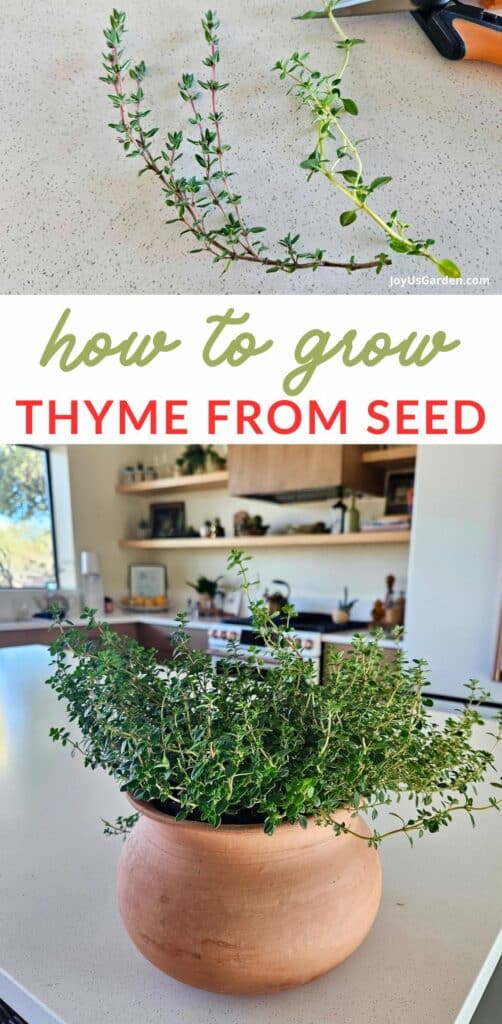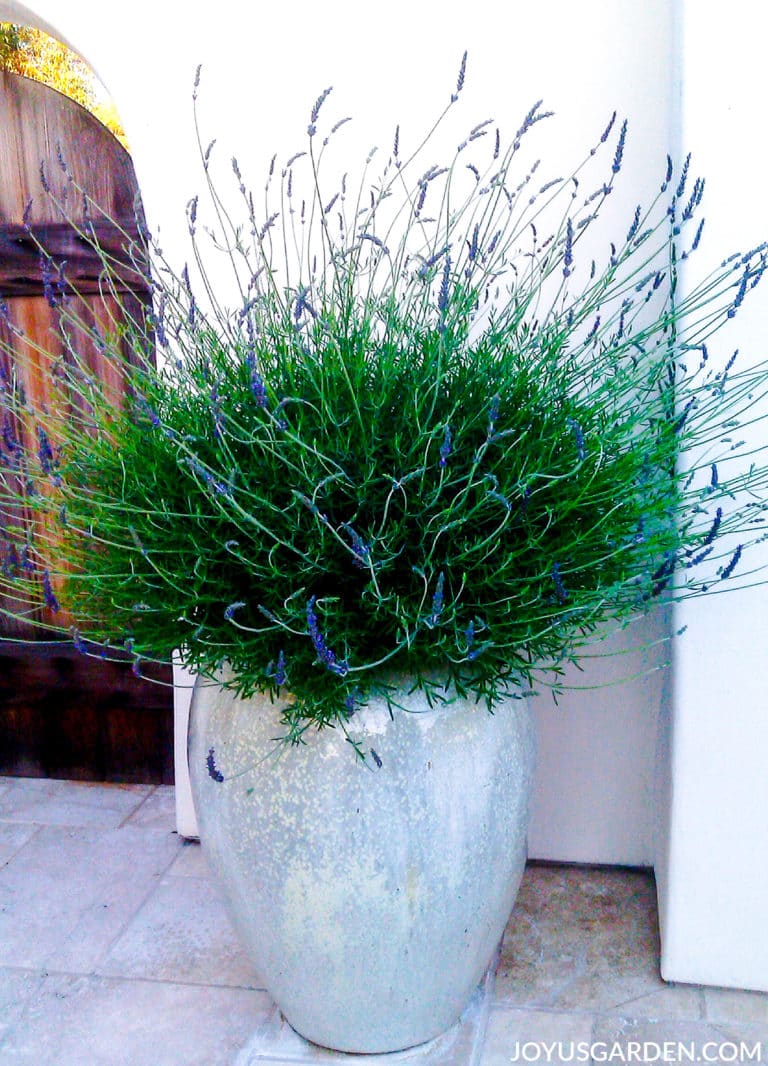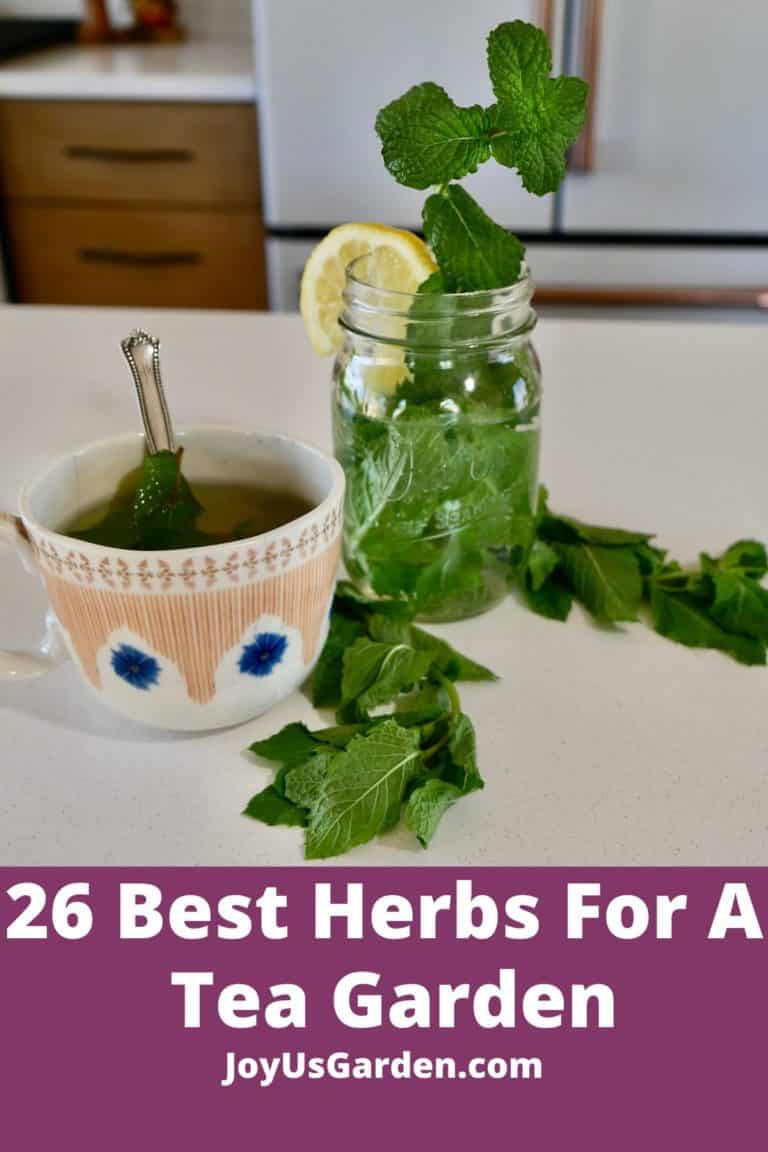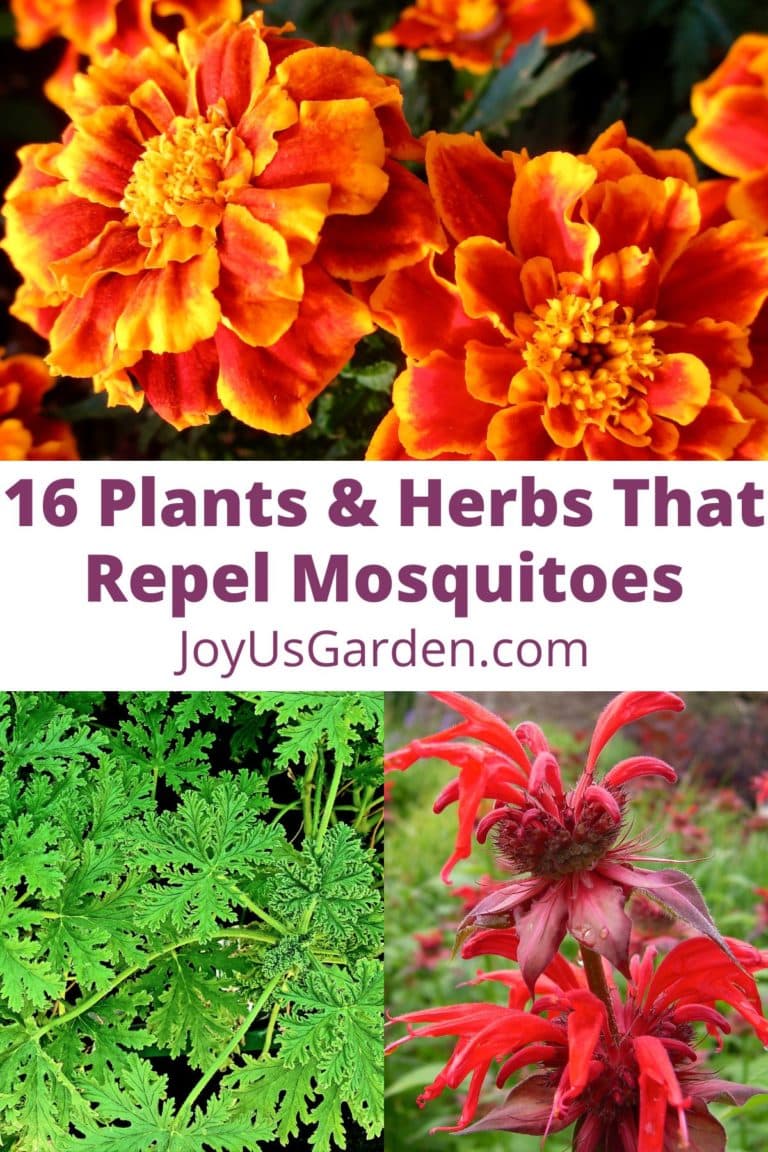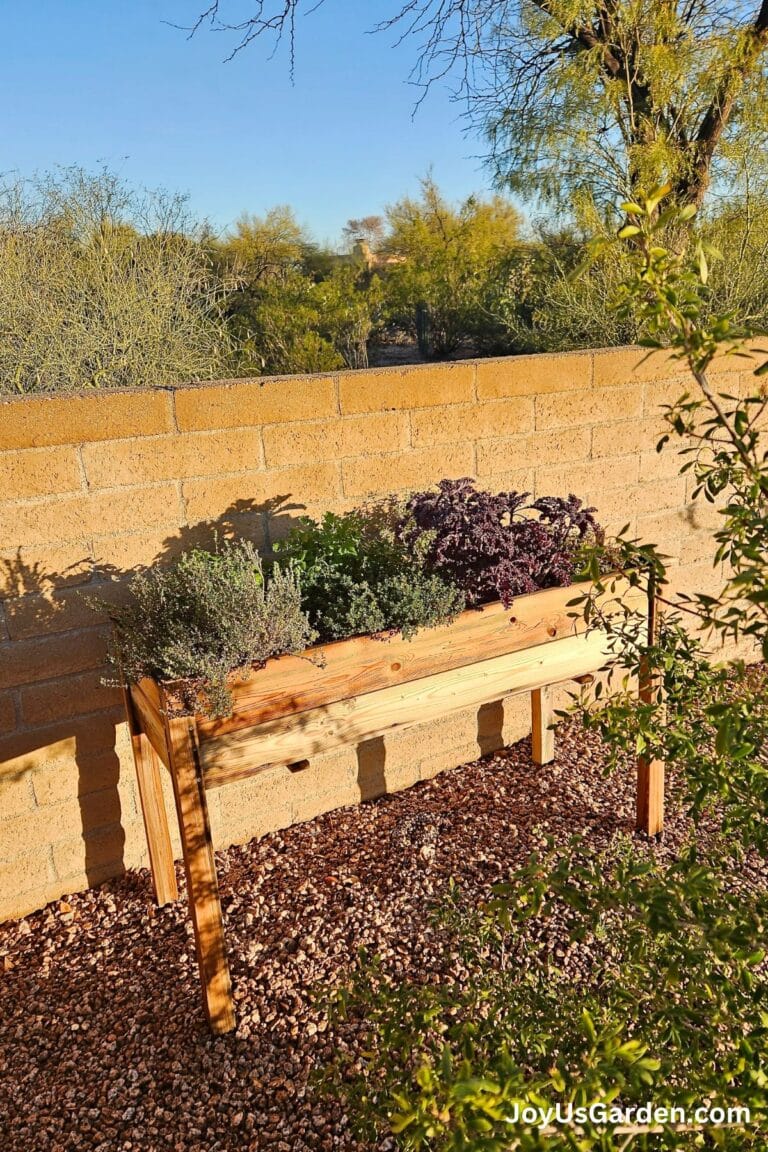How To Grow Thyme In Pots: Tips For Indoors & Outdoors
This aromatic herb does well in containers. Learn how to grow thyme in pots, in the garden, and your home.
Common thyme (Thymus vulgaris) is an easy-to-grow, perennial herb that can be used fresh or dried in salad dressings, roasted dishes, soups, and more. Thyme can be planted with other Mediterranean herbs in a culinary herb garden or you can keep thyme as a companion plant in a vegetable garden to attract pollinators and repel pests.
However, if you’re gardening in a small space, you can also grow thyme in a container garden or a small pot on a sunny windowsill and enjoy fresh thyme throughout the year!
This post may contain affiliate links, you can read our policies here.
How To Grow Thyme In Pots

Types Of Thyme
Thyme is a member of the mint family, and there are over 350 different varieties of thyme to choose from, including:
Lemon Thyme
Lemon thyme has a bright, lemony flavor, which is a delightful addition to chicken dishes, smoothies, and hot and cold beverages. While this plant closely resembles English thyme, you can easily identify lemon thyme by crushing its small leaves between your fingers and breathing in its fresh, citrus-like scent!
French Thyme
Thyme leaves have a powerful taste that can sometimes overwhelm subtle flavors. If this has troubled you in the past, you may want to experiment with French thyme, which has a sweeter and milder taste than common garden thyme.
English Thyme
Also known as common or garden thyme, English thyme is frequently sold at garden centers, although you can grow this plant from seeds or cuttings, too. With countless culinary uses, many chefs insist that English thyme has the best flavor and use it in roasted dishes and other hearty fare.
German Thyme
Like English thyme, German thyme produces an abundance of tiny, pink flowers in May through July, and it sports small, green leaves packed with flavor. However, German thyme is a bit mellower in taste than English thyme, and it’s slightly more cold hardy, too.
Creeping Thyme
Creeping thyme is edible, but most gardeners grow this plant as an ornamental, low maintenance ground cover. When this plant flowers in the summer months, it produces tons of tiny, pink blooms that bees can’t resist!
Silver Thyme
Silver thyme is a less common thyme variety, and you may have trouble locating it at your local garden center. However, if you can get your hands on this pretty plant, you’ll be wowed by silver thyme’s lemony taste and attractive leaves, which are edged in silver.
Caraway Thyme
Caraway thyme has a distinct flavor that tastes so much like caraway seeds that it can be used as a caraway substitute in recipes. Grow this low growing, perennial plant as a groundcover or keep it in a small clay pot… it’s up to you!
Pot Selection
Thanks to its compact size and shallow root system, thyme thrives in small terracotta pots and other types (ceramic, plastic, or composite) that are at least 6” deep by 12” wide. Select a larger pot or a small, raised bed container and space plants at least 12” apart to grow multiple thyme plants together.
Also, make sure that there are plenty of drainage holes at the bottom of the container you use, as good drainage is essential for preventing root rot.
Soil
In the wild, thyme naturally grows in dry conditions with well-draining soil. When growing thyme in pots, a standard potting mix is all you need, or you can make your own potting soil blend with organic matter and a good mix of sand.
We use Ocean Forest or Happy Frog for all our herb container planting adventures.
How To Grow From Seed
Thyme seeds can take over a month to germinate, so most gardeners start thyme from stem cuttings or nursery plants. However, if you want to cultivate hard-to-find thyme varieties, growing thyme from seed may be the best option.
Thyme seedlings are typically started indoors in late winter to early spring in containers filled with a premoistened seed starting mix. To plant, scatter thyme seeds lightly over the soil surface. Then, move the seeds under a bright grow light, water sparingly, and thin the seedlings out once they have a few sets of true leaves.
When spring arrives, go ahead and transplant your new thyme plants into pots or outdoor growing containers.
How To Plant Thyme In A Pot
Thyme is a hardy perennial that can be planted outdoors any time between spring and early fall, although the best time to plant thyme is after the last frost date in late spring. Indoor plants, on the other hand, can be planted year-round.
When you’re ready to plant thyme, add a few inches of well-drained soil to the bottom of a growing container. Position your thyme plant so it’s at the same depth that it was growing in its original pot, backfill the rest of the container with soil, and firm it around the base of the plant. Water new plants deeply and then move them to a bright location!
Feeding and Fertilizing Thyme
Thyme prefers poor soil to rich soil and doesn’t need much fertilizer to thrive. However, to stimulate fresh new growth, you can fertilize thyme about once a month during the growing season with a liquid seaweed fertilizer.
How To Grow Thyme in Pots Outdoors
Exposure
Outdoor thyme plants should be in a full sun location that receives at least 6 to 8 hours of direct sun daily.
Watering
Thyme thrives in dry soil and doesn’t need much water to grow. A mature plant typically only needs to be watered about once a week in summer and even less in cold weather; however, young plants and thyme grown in very small pots will dry out more quickly.
Soggy soil and wet roots are more likely to harm thyme than dry conditions, but parched plants will start to brown and drop leaves if they get too dry. A good rule of thumb is to test the soil before you water by inserting your finger into the plant’s potting mix. If the soil feels dry up to your knuckle, it’s time to water!
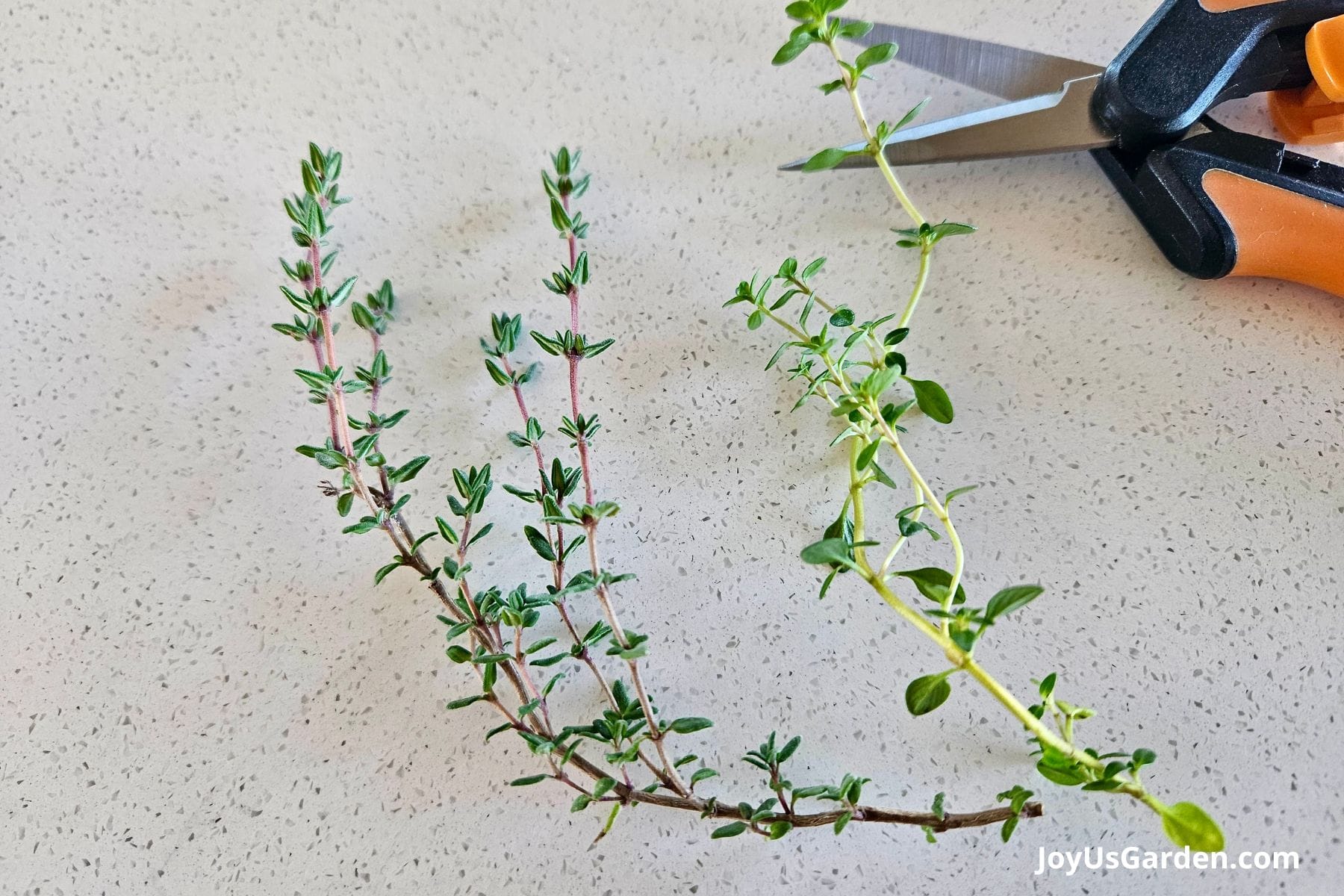
Pruning
If you harvest thyme regularly, pruning is usually unnecessary, although you can snip away wayward stems to keep your plant looking trim.
Thyme that’s not harvested often can develop woody stems, but this can be avoided by pruning back 1/3 of the plant’s oldest stems by half in late summer, after the plant finishes flowering.
Pests and Common Problems
Spider mites and aphids can sometimes target outdoor thyme and cause leaf discoloration and poor growth. Luckily, these pests are easy to treat with a strong blast from your garden hose and a bit of organic insecticidal soap or neem oil spray.
How To Grow Thyme in Pots Indoors
Exposure
Indoor thyme needs at least 6 to 8 hours of direct sunlight daily to grow properly. For best results, keep thyme in a south- or west-facing window with plenty of sunshine, or position your plants under a grow light.
Watering
While outdoor thyme doesn’t need much water, indoor thyme needs even less! Water indoor plants sparingly every week or two and make sure the excess water can flow freely out of the pot’s drainage holes.
Pruning
As with outdoor plants, indoor thyme doesn’t need to be pruned often as long as you harvest thyme stems regularly.
Pests and Common Problems
Pest insects are less likely to be a problem on indoor thyme plants; however, root rot and other fungal diseases are more likely to occur with indoor plants. Keeping watering to a minimum and ensuring good air circulation around your plants are the best ways to nip these problems in the bud.
Harvest and Store Thyme
You can pick a few fresh sprigs of thyme as needed throughout the growing season or cut up to 1/3 of the plant’s stems in spring or early summer for a larger harvest. Tender thyme stems can be clipped off at the soil line, while woody stems should be cut directly above a leaf node to encourage branching.
You’ll get the best flavor if you harvest in early summer, right before thyme flowers.
To store fresh thyme, wrap stems in a beeswax wrap and keep them in the fridge for up to 2 weeks. For longer storage, thyme leaves can be frozen in ice cube trays filled with water or olive oil, or you can dry thyme with air drying or a food dehydrator.

FAQ’s How To Grow Thyme In Pots
Thyme is a full sun plant and it may not receive enough sunlight indoors. As a result, it’s usually easier to grow thyme and other herbs outdoors.
Cutting thyme above a leaf node and never removing more than 1/3 of the plant’s stems at once is the best way to encourage branching and keep thyme plants happy.
Terracotta pots are one of the best choices for thyme as these pots are breathable and don’t hold onto water like plastic containers.
Happy Gardening,
-Lauren
